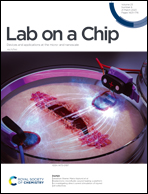Dynamic investigation of zein-based degradable and hemocompatible coatings for drug-eluting stents: a microfluidic approach†
Abstract
Biodegradable stent coatings have shown great potential in terms of delivering drugs to a damaged vessel wall, and their release profiles are key elements governing the overall performance of drug-eluting stents (DESs). However, release and degradation kinetics are usually not tested under simulated physiological conditions or in dynamic environments, both essential aspects in the design of novel DESs. To bridge this gap, fused silica-based microfluidic systems, with either round or square channel cross-sections, were designed to mimic the microenvironment of a stented vessel. In particular, we fabricated and characterized microfluidic chips based on customizable channels, which were spray-coated with a naturally-derived, rutin-loaded zein solution, to perform a comprehensive study under flow conditions. Dynamic assays after 6 hours showed how the degradation of the zein matrix was affected by the cross-sectional conformation (∼69% vs. ∼61%, square and round channel, respectively) and the simulated blood fluid components (∼55%, round channel with a more viscous solution). The released amount of rutin was ∼81% vs. ∼77% and ∼78% vs. ∼74% from the square and round channels, using the less and more viscous blood-simulated fluids, respectively. Fitting the drug release data to Korsmeyer–Peppas and first-order mathematical models provided further insight into the mechanism of rutin release and coating behavior under flowing conditions. More importantly, whole blood tests with our newly developed microfluidic platforms confirmed the hemocompatibility of our zein-based coating. In detail, in-flow and static studies on the blood cell behavior showed a significant reduction of platelet adhesion (∼73%) and activation (∼93%) compared to the stainless-steel substrate, confirming the benefits of using such naturally-derived coatings to avoid clogging. Overall, our microfluidic designs can provide a key practical tool for assessing polymer degradation and drug release from degradable matrices under flowing conditions, thus aiding future studies on the development of hemocompatible, controlled-release coatings for DESs.



 Please wait while we load your content...
Please wait while we load your content...